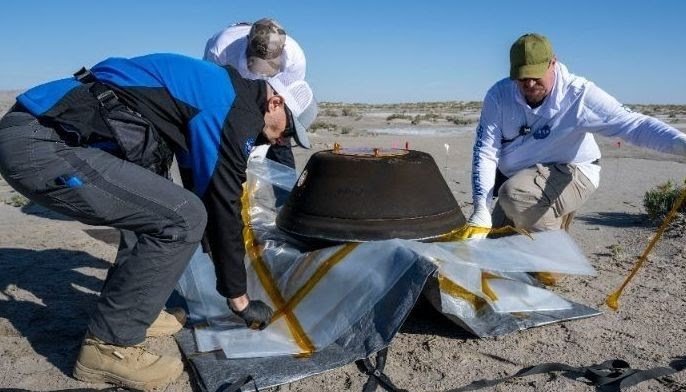A seven-year space voyage came to its climactic end Sunday when a NASA capsule landed in the desert in the US state of Utah, carrying to Earth the largest asteroid samples ever collected.
Scientists have high hopes for the samples, saying they will provide a better understanding of the formation of our Solar System and how Earth became habitable.
Completing a 3.86-billion-mile (6.21-billion-kilometer) journey, it marked the United States’ first sample return mission of its kind, the US space agency said in a post on X, the former Twitter.
NASA chief Bill Nelson hailed the mission and said the asteroid dust “will give scientists an extraordinary glimpse into the beginnings of our Solar System.”
Four years after its 2016 launch, the Osiris-Rex probe landed on the asteroid Bennu and collected what NASA estimated is roughly nine ounces (250 grams) of dust from its rocky surface.
Even that small amount, NASA says, should “help us better understand the types of asteroids that could threaten Earth.”
The samples return “is really historic,” NASA scientist Amy Simon told AFP, adding, “This is going to be the biggest samples we’ve brought back since the Apollo moon rocks” were returned to Earth.
Osiris-Rex released its capsule early Sunday from an altitude of more than 67,000 miles.
NASA images showed the tire-sized capsule on the ground in a desert wash, with scientists approaching the device and taking readings.
Eventually, they concluded the capsule was not breached, meaning its all-important air-tight seal remained intact, avoiding any contamination of samples with desert sands. The team then lifted the capsule by helicopter to a nearby “clean room.”
Meanwhile, the probe that made the space journey fired its engines and shifted course away from Earth, NASA said, “on its way” for a date with another asteroid, known as Apophis.
Scientists predict that asteroid will come within 20,000 miles of Earth in 2029.
On Monday, samples will head to Johnson Space Center in Houston for additional study, and NASA plans to announce its first results at a news conference October 11.
Most of the samples will be conserved for study by future generations. Roughly one-fourth will be immediately used in experiments, and a small amount will be sent to mission partners Japan and Canada.
Japan had earlier given NASA a few grains from asteroid Ryugu, after bringing 0.2 ounces of dust to Earth in 2020 during the Hayabusa-2 mission. Ten years before, it had brought back a microscopic quantity from another asteroid.
But the sample from Bennu is much larger, allowing for significantly more testing, Simon said.
Scientists believe Bennu, about 500 meters (1,640 feet) in diameter, is rich in carbon — a building block of life on Earth — and contains water molecules locked in minerals.
Bennu surprised scientists in 2020 when the probe, during its brief contact with the asteroid’s surface, sank into the soil, revealing an unexpectedly low density, like a children’s pool filled with plastic balls.





